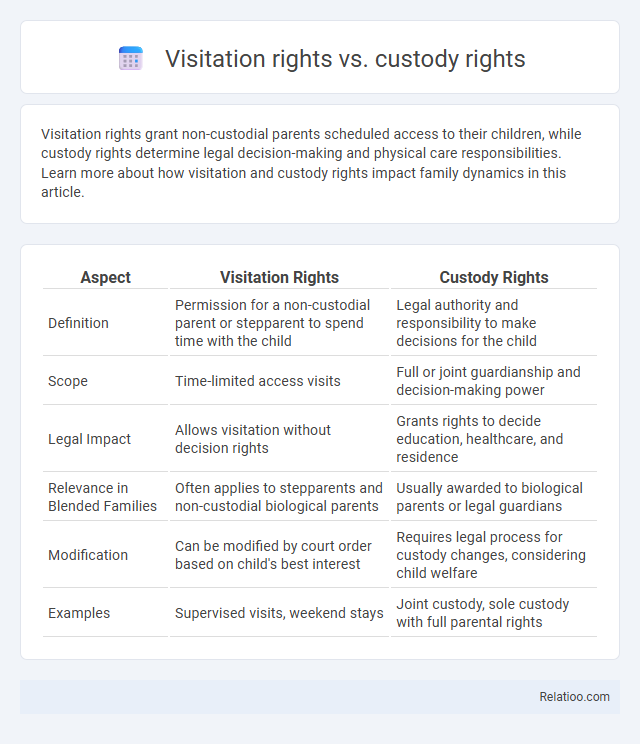Visitation rights grant non-custodial parents scheduled access to their children, while custody rights determine legal decision-making and physical care responsibilities. Learn more about how visitation and custody rights impact family dynamics in this article.
Table of Comparison
| Aspect | Visitation Rights | Custody Rights |
|---|---|---|
| Definition | Permission for a non-custodial parent or stepparent to spend time with the child | Legal authority and responsibility to make decisions for the child |
| Scope | Time-limited access visits | Full or joint guardianship and decision-making power |
| Legal Impact | Allows visitation without decision rights | Grants rights to decide education, healthcare, and residence |
| Relevance in Blended Families | Often applies to stepparents and non-custodial biological parents | Usually awarded to biological parents or legal guardians |
| Modification | Can be modified by court order based on child's best interest | Requires legal process for custody changes, considering child welfare |
| Examples | Supervised visits, weekend stays | Joint custody, sole custody with full parental rights |
Understanding Visitation Rights
Visitation rights grant a non-custodial parent scheduled access to their child, ensuring meaningful contact despite not having primary custody. Custody rights, including physical and legal custody, define who makes key decisions and where the child primarily lives. Your understanding of visitation rights helps maintain your relationship with the child while respecting the custodial parent's responsibilities.
Defining Custody Rights
Custody rights refer to the legal authority granted to a parent or guardian to make decisions about a child's upbringing, including education, health care, and welfare. This encompasses both physical custody, which determines where the child lives, and legal custody, which involves decision-making power. Visitation rights allow the non-custodial parent or guardian scheduled time to spend with the child but do not confer decision-making authority.
Key Differences Between Visitation and Custody
Visitation rights grant a non-custodial parent scheduled time to spend with their child, ensuring ongoing parental involvement without granting decision-making authority. Custody rights, split into legal and physical custody, allow a parent to make significant decisions about the child's welfare and determine where the child lives. Understanding these distinctions helps you navigate parental responsibilities and protect your child's best interests effectively.
Types of Visitation Arrangements
Visitation rights determine the schedule and conditions under which a non-custodial parent spends time with their child, while custody rights govern the legal decision-making authority and physical living arrangements of the child. Types of visitation arrangements include supervised visitation, where a third party monitors interactions; unsupervised visitation, allowing private time between parent and child; and virtual visitation, which utilizes technology for remote communication. These arrangements cater to varying family circumstances and aim to balance the child's best interests with parents' rights.
Types of Child Custody
Types of child custody primarily include legal custody, which grants decision-making authority over the child's welfare, and physical custody, referring to where the child resides. Visitation rights, or parenting time, allow the non-custodial parent scheduled time to spend with the child, emphasizing maintaining a relationship without holding custody. Joint custody involves shared legal or physical custody, while sole custody places both rights with one parent, impacting visitation and parental involvement.
Legal Factors Affecting Rights
Legal factors affecting visitation rights, custody rights, and overall custody include the child's best interests, parental fitness, and existing custody agreements. Courts evaluate parental stability, history of abuse or neglect, and the ability to provide a safe environment when determining your visitation or custody rights. Custody decisions also consider the child's relationship with each parent and their emotional and physical needs.
Modifying Visitation and Custody Orders
Modifying visitation and custody orders involves demonstrating a significant change in circumstances affecting the child's best interests, such as relocation, changes in parental behavior, or evolving needs of the child. You must file a petition with the court, providing evidence supporting the need for modification to either visitation or custody arrangements. Courts prioritize stability and the child's welfare when deciding to adjust custody and visitation orders.
Rights of Non-Custodial Parents
Non-custodial parents typically have visitation rights, which allow them to spend scheduled time with their child, while custodial parents retain primary custody and decision-making authority. Visitation rights ensure that non-custodial parents maintain a meaningful relationship with their child despite not holding physical or legal custody. Understanding your visitation rights is crucial for maintaining your role in your child's life and participating in their upbringing.
Impact on the Child’s Wellbeing
Custody rights determine the legal responsibility for a child's care and decision-making, directly influencing their stability and overall wellbeing. Visitation rights allow a non-custodial parent to maintain a relationship, which supports emotional development and a sense of security in the child. Balancing custody and visitation effectively promotes consistent nurturing environments, reducing stress and fostering healthy psychological growth.
Resolving Disputes Over Visitation and Custody
Resolving disputes over visitation and custody involves understanding the distinctions between visitation rights, which allow a non-custodial parent to spend time with their child, and custody rights, which determine the legal responsibility for the child's care and decision-making. Courts prioritize the child's best interests by evaluating parental fitness, the nature of the parent-child relationship, and the child's needs when making custody or visitation decisions. You can improve the resolution process by seeking mediation or a collaborative legal approach, ensuring that agreements focus on stable, consistent contact to support the child's well-being.

Infographic: Visitation rights vs custody rights
 relatioo.com
relatioo.com